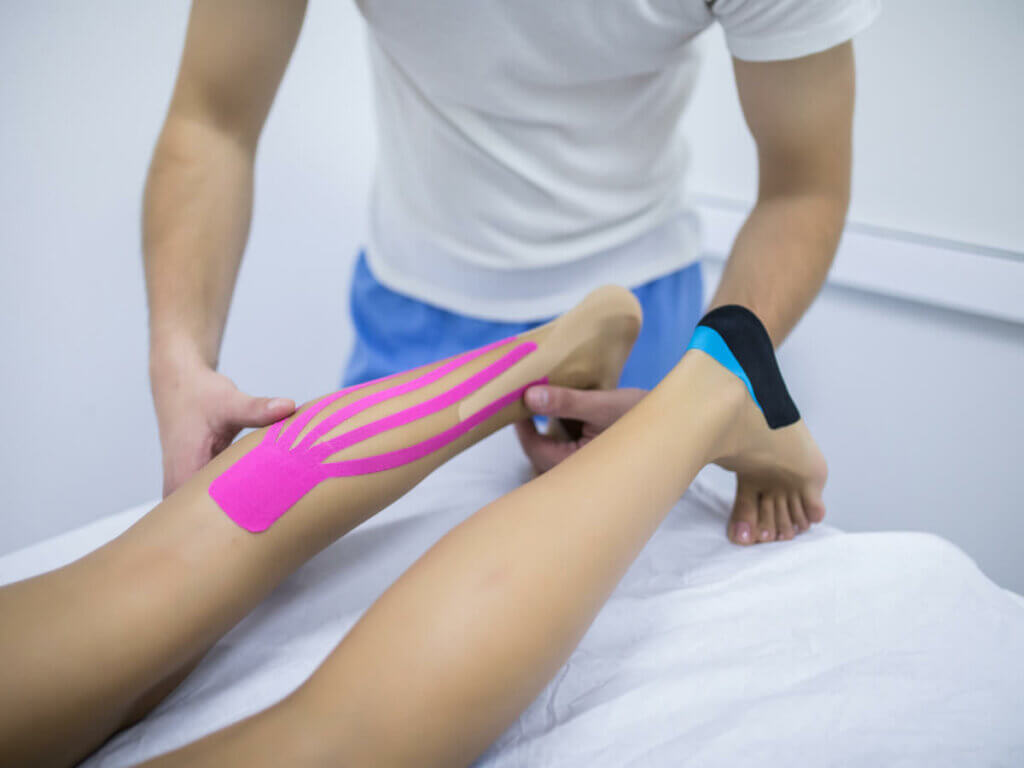What Does Kinesio Tape Do?

Over recent years the use of Kinesio tape has become more and more common. Its uses and functions are taught at universities, and people with coloured strips on their bodies are seen in everyday life in any city in the world. But what does it do?
In this article, we’ll explain in detail what this elastic material does. What are its most effective uses? Have we reached a point where we’re using it too much?
Basic concept of Kinesio tape
Kinesio tape is a method of bandaging based on applying elastic strips over the muscles or the zones where the patient is affected. In these circumstances the bandages can stretch up to 100 percent of their length.
The bandages also have an adhesive part that makes it easy to stick them directly to the skin. You have to stretch the strips of the Kinesio tape and then stick them to the body. This way, the bandage creates a constant tension over the patients’ skin. You can change the tension based on how much you stretch the strip before sticking it down.
The main uses of Kinesio tape
Despite the fact that in some cases Kinesio tape‘s effectiveness isn’t clear, in many situations it is. For example, it’s been shown to have the capacity to improve the range of movement in those with shoulder issues.
There are also cases where Kinesio tape helps to improve the posture of the humorous bone in relation to the shoulder blade for patients with issues in that area, as confirmed by a study published in the International Journal of Physical Therapy.

Kinesio tape can also be used as a sensory reminder. If someone is suffering a problem with their leg, the presence of the tape will ensure that the patient is aware when they stretch that extremity. That way, the injured person will remember they need to take care with that part of their body and not overwork it.
However, there are many studies that have shown this method isn’t effective in improving certain aspects in healthy patients. For example, a study published in the Journal of Orthopaedic and Sports Physical Therapy suggests that the tape doesn’t help to accelerate muscular contraction after receiving a sudden stimulus.
In fact, in the first study we mentioned, they suggest that the tape doesn’t aid the pain, beyond supporting mobility. So in this sense, it isn’t really effective either.
It’s not a miracle therapy
As mentioned above, it’s clear that you shouldn’t use Kinesio tape without a proper reason. This type of neuromuscular bandage is often applied to treat muscular pain. However, as we’ve seen there are cases where the tape is effective, and there are cases where it isn’t.
The effectiveness of the Kinesio tape, therefore, depends on your reason for using it. It’s also important to remember that it’s difficult to carry out studies on all of the possible uses, meaning that there’s still not enough scientific evidence. But certain uses can produce positive results. That being said, other techniques that are supported by scientific evidence may be a safer alternative.
Extensive range of applications
To clarify how difficult it’d be to gather scientific data on Kinesio tape, it’s important to look at all the ways it can be applied: as an I shape, an X shape, a star, or an octopus shape…to name a few.

Those are shapes the bandages make on the patient’s skin and each one has a different purpose. The bandages also come in different colours with varying levels of stretchiness, but you can use any technique with them.
The many different application styles have a range of benefits for circulation, drainage, and cartilage-based issues (fascia). However there are no studies that confirm or deny this.
Kinesio tape: another tool
Having read all of the above, it should be clear that Kinesio tape can be an effective tool. Nowadays, it’s commonplace for physiotherapists to give you it during your consultation. Its positive effects over the range of movement, the patients’ awareness of their body (proprioception), and its ability to act as a constant reminder for the patient are significant.
It’s important to remember that in many cases the most effective way of using the tape is as part of a larger treatment. It can compliment other treatments and help patients in two or three days after its initial application.
This article details what we should do when using Kinesio tape. Future studies will determine the longevity of the effects that the bandages offer.
Over recent years the use of Kinesio tape has become more and more common. Its uses and functions are taught at universities, and people with coloured strips on their bodies are seen in everyday life in any city in the world. But what does it do?
In this article, we’ll explain in detail what this elastic material does. What are its most effective uses? Have we reached a point where we’re using it too much?
Basic concept of Kinesio tape
Kinesio tape is a method of bandaging based on applying elastic strips over the muscles or the zones where the patient is affected. In these circumstances the bandages can stretch up to 100 percent of their length.
The bandages also have an adhesive part that makes it easy to stick them directly to the skin. You have to stretch the strips of the Kinesio tape and then stick them to the body. This way, the bandage creates a constant tension over the patients’ skin. You can change the tension based on how much you stretch the strip before sticking it down.
The main uses of Kinesio tape
Despite the fact that in some cases Kinesio tape‘s effectiveness isn’t clear, in many situations it is. For example, it’s been shown to have the capacity to improve the range of movement in those with shoulder issues.
There are also cases where Kinesio tape helps to improve the posture of the humorous bone in relation to the shoulder blade for patients with issues in that area, as confirmed by a study published in the International Journal of Physical Therapy.

Kinesio tape can also be used as a sensory reminder. If someone is suffering a problem with their leg, the presence of the tape will ensure that the patient is aware when they stretch that extremity. That way, the injured person will remember they need to take care with that part of their body and not overwork it.
However, there are many studies that have shown this method isn’t effective in improving certain aspects in healthy patients. For example, a study published in the Journal of Orthopaedic and Sports Physical Therapy suggests that the tape doesn’t help to accelerate muscular contraction after receiving a sudden stimulus.
In fact, in the first study we mentioned, they suggest that the tape doesn’t aid the pain, beyond supporting mobility. So in this sense, it isn’t really effective either.
It’s not a miracle therapy
As mentioned above, it’s clear that you shouldn’t use Kinesio tape without a proper reason. This type of neuromuscular bandage is often applied to treat muscular pain. However, as we’ve seen there are cases where the tape is effective, and there are cases where it isn’t.
The effectiveness of the Kinesio tape, therefore, depends on your reason for using it. It’s also important to remember that it’s difficult to carry out studies on all of the possible uses, meaning that there’s still not enough scientific evidence. But certain uses can produce positive results. That being said, other techniques that are supported by scientific evidence may be a safer alternative.
Extensive range of applications
To clarify how difficult it’d be to gather scientific data on Kinesio tape, it’s important to look at all the ways it can be applied: as an I shape, an X shape, a star, or an octopus shape…to name a few.

Those are shapes the bandages make on the patient’s skin and each one has a different purpose. The bandages also come in different colours with varying levels of stretchiness, but you can use any technique with them.
The many different application styles have a range of benefits for circulation, drainage, and cartilage-based issues (fascia). However there are no studies that confirm or deny this.
Kinesio tape: another tool
Having read all of the above, it should be clear that Kinesio tape can be an effective tool. Nowadays, it’s commonplace for physiotherapists to give you it during your consultation. Its positive effects over the range of movement, the patients’ awareness of their body (proprioception), and its ability to act as a constant reminder for the patient are significant.
It’s important to remember that in many cases the most effective way of using the tape is as part of a larger treatment. It can compliment other treatments and help patients in two or three days after its initial application.
This article details what we should do when using Kinesio tape. Future studies will determine the longevity of the effects that the bandages offer.
All cited sources were thoroughly reviewed by our team to ensure their quality, reliability, currency, and validity. The bibliography of this article was considered reliable and of academic or scientific accuracy.
- M. Thelen, J. Dauber y P. Stoneman. The Clinical Efficacy of Kinesio Tape for Shoulder Pain: A Randomized, Double-Blinded, Clinical Trial. Journal of Orthopaedic & Sports Physical Therapy. July 1, 2008; Volume 38, Issue 7, Pages389-395
- S. Walsh. Treatment of a brachial plexus injury using kinesiotape and exercise, Physiotherapy Theory and Practice, 26:7, 490-496; 2010
- K. Briem, H. Eythörsdöttir, R. Magnúsdóttir et al. Effects of Kinesio Tape Compared With Nonelastic Sports Tape and the Untaped Ankle During a Sudden Inversion Perturbation in Male Athletes. Journal of Orthopaedic & Sports Physical Therapy. May 1, 2011; Volume 41, Issue 5, Pages328-335
This text is provided for informational purposes only and does not replace consultation with a professional. If in doubt, consult your specialist.








